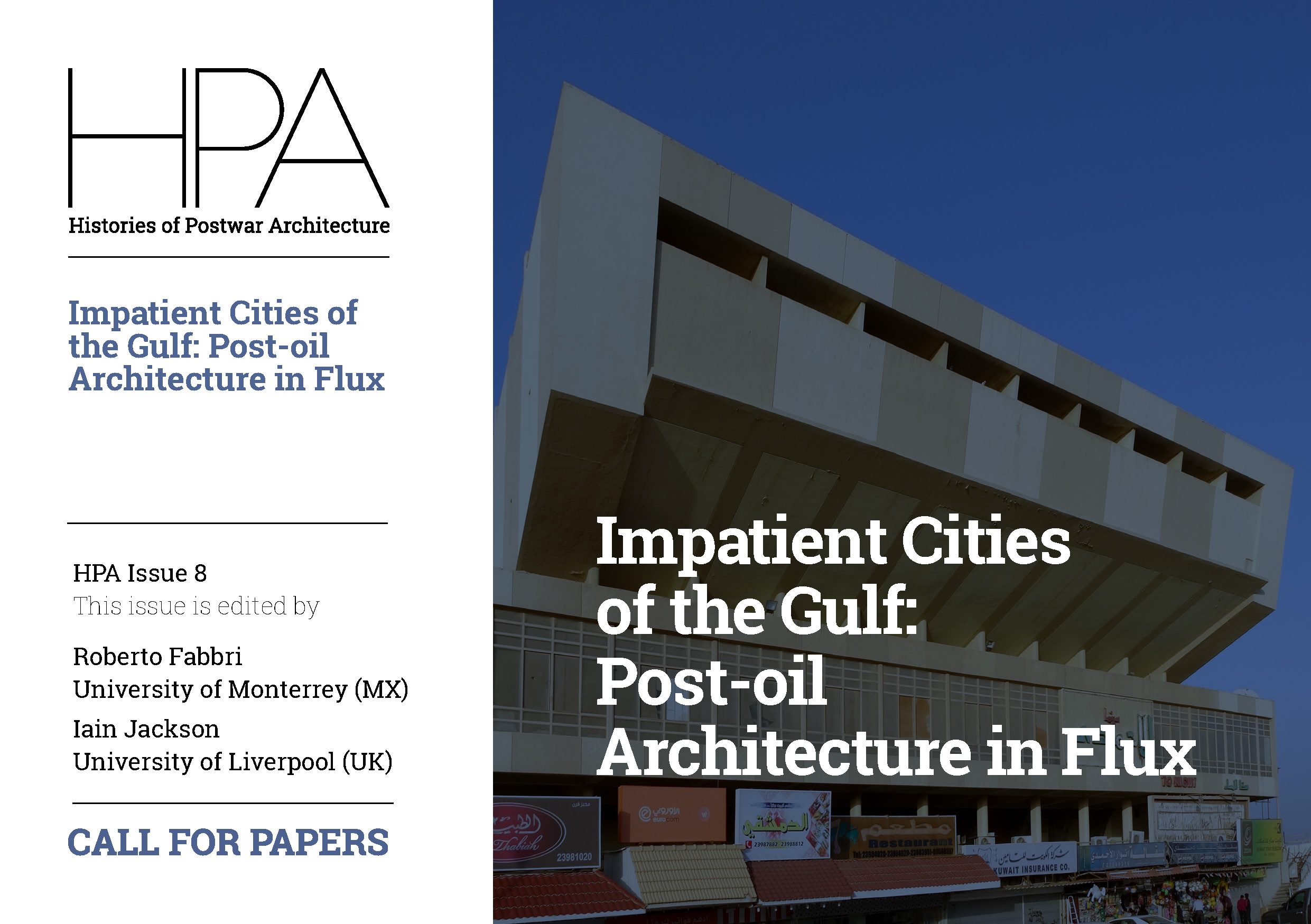Impatient Cities of the Gulf: Post-oil Architecture in Flux - Call for Papers - HPA 8/2021

Today’s general perception of Gulf cities is based on the assumption of a futuristic vision; a visionary development and a cluster of hi-tech constructions.
Since the striking of oil, this ‘brave new world’ has been a testing ground for experimental, risk imbued architecture and real estate. The sudden affluence and ambition of the rulers to demonstrate progress and social advancements (sometimes expressed through outlandish ‘iconic’ designs) has certainly fired this drive. The building of cities seemed an appropriate culvert for the vast funds generated, turning what was once barren into a fertile land.
Furthermore, there is an ever-present sense of the ‘tabula-rasa approach’ that forced (or perhaps tempted) architects to pursue different and alternative design processes. Gulf cities seem to permit the idea, if not always the reality, of being able to ‘start again’, to be re-made, re-imagined and re-Modernised. There is a sense of being forever in the ‘now’, with ‘historical’ projects stretching back mere decades. Perhaps this desire to continually reinvent brought about shortcomings in early Modernist paradigms, and the rapid rise of new social/cultural/artistic concepts (such as pop art/metabolism/structuralism/post-modernism/idiosyncratic and so on).
These preliminary reflections offer an image of the Gulf as a fluid ambit that challenged designers for several decades in the light of a central question: how do architects build in a place with a constantly changing context? How are ideas of history, tradition, memory, and heritage constructed in this flux?
In the second half of the 20th century, the circumstantial conditions generated a series of experimental, utopian, sometimes unbuildable projects with a high level of idealisation. Some are renowned such proposals as Wright’s plan for Baghdad or the Smithsons’ Kuwait mat-building. Many are still to be unearthed as they were shelved and never implemented, or abandoned along the way, altered or demolished.
In other cases, the region's specific constraints - such as limited material availability, narrow construction time and harsh climate, led architects to original ideas, technologies, and procurement methods with highly inventive and analytical processes.
Moreover, modern architecture in the Gulf seems somehow different for sporting an urge for negotiating the local context by ‘flirting’ with traditional elements of locality, such as geometrical motifs, shapes, textures or colour palette. The liberal application of decorative motifs, patterns, applied ornamentation needs careful examination, especially when it is so diligently applied to forms and arrangements more generally associated with a more austere modernist agenda.
The editors invite papers that extend the discussion on the Gulf built environment during the modernisation era, over the duality global/local as terms in opposition. Contributions are encouraged to analyse different architectural narratives, approaches and schools of thought to compensate the assumption that flattens ‘modernity’ as a one-directional, repetitive and monotone practice acquired and acritically transplanted into the Arab Peninsula.
Focusing on the second half of the 20th century, and with an eye on the contemporary implications, possible topics include, but they are not limited to:
- Experimental and inventive design practices
- Global aspiration and local constraints
- Context negotiation
- Materiality
- Knowledge exchanges and bijective practices
- Modernity, tradition and transition
- De-colonial urbanism
- Identity formation and the built environment
- Place-making, streetscapes and scale
Authors must submit directly full papers using hpa.unibo.it.
The guidelines for paper submission are available at https://hpa.unibo.it/about/submissions#authorGuidelines
Please, fill in the author’s profile with all the information required as:
• Applicant’s name
• Professional affiliation
• Title of paper
• Abstract
• 5 keywords
• A brief CV (max 2,000 characters)
Please submit the proposal in the form of MS Word (length between 4,200 and 8,500 words). The submitted paper must be anonymous. Please delete from the text and file’s properties all information about name, administrator etc. Papers should clearly define the argument in relation to the available literature and indicate the sources which the paper is based on.
All papers received will go through a process of double-blind peer review before publication.
HPA also looks for contributions for the review section. https://hpa.unibo.it/about/editorialPolicies#sectionPolicies
To addressed questions to the editors:
roberto.fabbri@udem.edu
Iain.Jackson@liverpool.ac.uk
- 31 December: Deadline for paper submission
- January: Notification of acceptance
- January-March: Peer-review process
- April-May: Copy editing and proofreading
- June 2021: Publication




